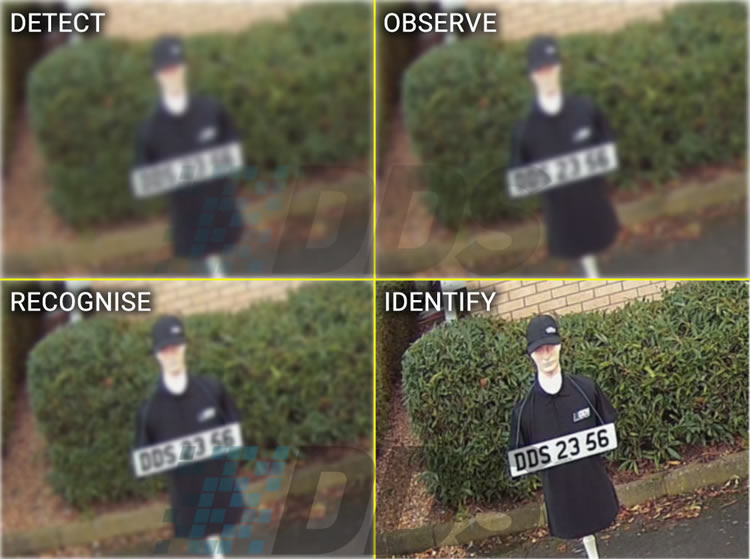What is DORI?
The DORI standard, which stands for Detection, Observation, Recognition, and Identification, is based on the IEC EN62676-4: 2015 International Standard and specifies how far a camera can view. DORI uses PPM (Pixels Per Meter) to define the terms Detection (25ppm), Observation (62ppm), Recognition (125ppm), and Identification (250ppm). These PPM values allow you to choose a particular camera sensor and lens combination and confirm that it will deliver the performance required in each application based on the factors mentioned above.
Detection
The detection level (25ppm) allows for reliable determination of whether a person or vehicle is present, although few details will be visible.
Observation
The observation level (62ppm) gives characteristic details of an individual, such as distinctive clothing, while allowing a view of the activity occurring.
Recognition
The recognition level (125ppm) determines with a high degree of certainty whether an individual shown is the same as someone that has been seen before. Vehicle license plates will also become legible.
Identify
The identification level (250ppm) makes it possible to identify a person without a shadow of a doubt. The detail provides enough quality to identify an individual or clearly read a vehicle's license plate.

How to use DORI?
To effectively make use of DORI, you need to consider the resolution of the camera sensor and the lens. Using the 2MP Uniview EasyStar turret, it has different levels of DORI depending on which lens is used:
| Detect | Observe | Recognise | Identify | |
| IPC3612LB-ADF28K (2.8mm) | 42.0m | 16.8m | 8.4m | 4.2m |
| IPC3612LB-ADF40K (4.0mm) | 60.0m | 24.0m | 12.0m | 6.0m |
As you can see from the table above, a 2.8mm lens would allow you to identify someone from 4.2m, whereas a 4.0mm lens allows a distance of 6.0m. This is due to the focal length of the lens being shorter, which results in a wider angle shot; whilst a longer focal length results in a narrower shot meaning it "sees" a little further away. However, as mentioned previously, you also need to consider the resolution of the camera sensor. Using a 5MP and 8MP Uniview LightHunter turret, both with a 2.8mm lens, we can observe the following:
| Detect | Observe | Recognise | Identify | |
| IPC3615SB-ADF28KM-I0 (5MP) | 63.0m | 25.2m | 12.6m | 6.3m |
| IPC3618SB-ADF28KM-I0 (8MP) | 84.0m | 33.6m | 16.8m | 8.4m |
As you can see from the table above, a 5MP sensor would allow you to identify someone from 6.3m, whereas an 8MP sensor allows a distance of 8.4m. This is due to the pixel count of the sensor being much higher, which results in more pixels being available to capture the image.
